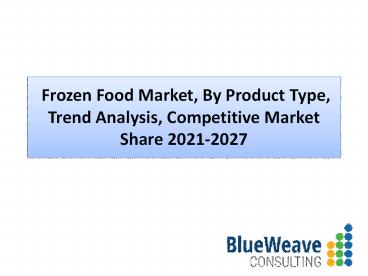Frozen Food Market Industry Trends & Forecast Report 2027 - PowerPoint PPT Presentation
Title:
Frozen Food Market Industry Trends & Forecast Report 2027
Description:
Global frozen food market was worth USD 245.1 billion in 2020. It is further projected to reach USD 342.9 billion by 2027, at a CAGR of 5.0% during 2021-2027 (forecast period). – PowerPoint PPT presentation
Number of Views:92
Title: Frozen Food Market Industry Trends & Forecast Report 2027
1
Frozen Food Market, By Product Type, Trend
Analysis, Competitive Market Share 2021-2027
2
Industry Trends Forecast Report 2027 A recent
study conducted by the strategic consulting and
market research firm BlueWeave Consulting revealed
that the global frozen food market was worth USD
245.1 billion in the year 2020. It is and is
further projected to reach USD 342.9 billion by
2027, at a CAGR of 5.0 during the forecast
period (2021-2027). The demand for frozen food is
expected to grow in the near future as a result
of hectic lifestyles among working-class people
around the world and rising expenditure on
ambient (shelf-stable) foods by consumers. Frozen
food is now considered a viable option by
millennial consumers due to its convenience.
Additionally, fast service restaurants (such as
KFC, Domino's, and Subway), bars, hotels, and
healthcare canteens have expanded their use of
frozen foods in order to keep their servings
cost-effective and timely.
3
Growth Drivers Increased demand for convenience
in food Because of the hectic lifestyles of
millennials and the increasing working
population, the frozen food market has grown
steadily, especially in ready meals, frozen meat,
on-the-go food, and other categories. Frozen
foods have grown in popularity in urban areas
because they need less time and effort to prepare
than fresh produce. According to the World Bank,
approximately 55 of the world's population lives
in urban areas as of 2020, and by 2045, the
figure is projected to rise by 1.5 times to 6
billion. Furthermore, the rise in disposable
income of many households, combined with the
impulsive buying trend among consumers, has led
to an increase in the consumption of frozen
food. Freezing of food extends their shelf life
and makes them free from any added preservative.
4
Restraints Consumer preference for fresh and
organic foods Frozen food is widely regarded as
a poor replacement for fresh food by the general
public. It is assumed that food that has been
stored for more than a year loses all of its
nutritional value. However, such myths were
broken by the U.S. Food and Drug Administration
(FDA) and the International Food Information
Council (IFIC). While nutrients such as vitamin C
and folate can decompose due to temperature
changes, nutrients are retained in frozen
vegetables by storing at a constant low
temperature or below the freezing point. This
myth about frozen food can be resolved by raising
customer consciousness about the quality of
frozen foods.
5
Impact of COVID-19 With the advent of the
COVID-19 pandemic, which caused many countries to
declare a state of emergency, customers opted to
eat more family meals than ever before. Frozen
foods were the most convenient and cost-effective
solution for families during the lockdown phase.
Frozen food items offer the benefit of a longer
shelf life than natural produce thus, saving
consumers from making daily trips to the store
and exposing themselves to the virus. According
to the American Frozen Food Institute (AFFI),
frozen foods accounted for USD 65.1 billion in
retail sales in 2020, representing a 21 rise
over the previous year.
6
Global Frozen Food Market Regional Insights The
global frozen food market is categorized into
North America, Europe, the Asia-Pacific, Latin
America, the Middle East Africa. In 2020,
Europe accounted for the largest share in the
frozen food market. Recently, Europe has seen a
large increase in the number of vegans, which has
boosted sales of frozen vegetables and their
products in the region. Increased urbanization,
higher purchasing power, economic stability, and
changes in dietary preferences are some of the
other driving factors. The sudden outbreak of the
pandemic also increased the sales of frozen foods
in this region
7
Competitive Landscape The frozen food market is
highly fragmented, with regional and foreign
players competing for market share. Companies are
continuously competing on various attributes such
as product offerings, composition, quality,
taste, flavors, price, scale, packaging, and
marketing activities. The key players in this
market are- General Mills Inc., Conagra Brands
Inc., Nestle SA, Unilever, Kellogg Company,
McCain Foods Limited, Kraft Heinz Company,
Associated British Foods plc, Ajinomoto, Kuppies,
Omar International Pvt Ltd., Shishi He Deming,
and other prominent players.Sample Copy of the
Report https//www.blueweaveconsulting.com/report
/global-frozen-food-market/report-sample
8
About Us Blueweave Consulting offers a one-stop
solution for your market intelligence needs for
any service or product. You get well-researched
comprehensive reports based on qualitative and
quantitative data to put your business plan into
action. Your well-informed and timely decisions
using our reports avert situations of excessive
risks and help you grow your business with
optimum risk-return trade-off. Delivering
quality insights into several product or service
markets within the timeline as per the needs of
the clients has earned BWC an excellent
reputation among clients. BWC strives to provide
timely and accurate digital market intelligence
services for making your business endeavors
successful.
9
Contact Us
1 866 658 6826 1 425 320 4776
44 1865 60 0662
info(_at_)blueweaveconsulting.com
www.blueweaveconsulting.com





















![Meat Products Market, Global Industry Size Forecast [Latest] PowerPoint PPT Presentation](https://s3.amazonaws.com/images.powershow.com/9972117.th0.jpg?_=20231206075)
![Meat Products Market, Global Industry Size Forecast [Latest] (1) PowerPoint PPT Presentation](https://s3.amazonaws.com/images.powershow.com/9972115.th0.jpg?_=20231206075)








